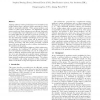Free Online Productivity Tools
i2Speak
i2Symbol
i2OCR
iTex2Img
iWeb2Print
iWeb2Shot
i2Type
iPdf2Split
iPdf2Merge
i2Bopomofo
i2Arabic
i2Style
i2Image
i2PDF
iLatex2Rtf
Sci2ools
SIGCOMM
1994
ACM
1994
ACM
An Architecture for Wide-Area Multicast Routing
Existing multicast routing mechanisms were intended for use within regions where a group is widely represented or bandwidth is universally plentiful. When group members, and senders to those group members, are distributed sparsely across a wide area, these schemes are not e cient data packets or membership report information are occasionally sent over many links that do not lead to receivers or senders, respectively. We have developed a multicast routing architecture that e ciently establishes distribution trees across wide area internets, where many groups will be sparsely represented. E ciency is measured in terms of the state, control message processing, and data packet processing, required across the entire network in order to deliver data packets to the members of the group. Our Protocol Independent Multicast (PIM) architecture: (a) maintains the traditional IP multicast service model of receiver-initiated membership (b) can be con gured to adapt to di erent multicast group and n...
| Added | 10 Aug 2010 |
| Updated | 10 Aug 2010 |
| Type | Conference |
| Year | 1994 |
| Where | SIGCOMM |
| Authors | Stephen E. Deering, Deborah Estrin, Dino Farinacci, Van Jacobson, Ching-Gung Liu, Liming Wei |
Comments (0)

